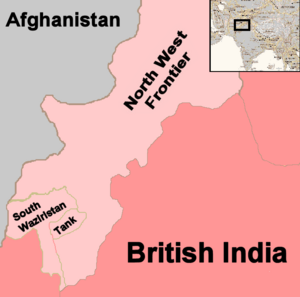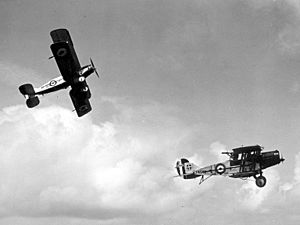Pink's War facts for kids
Quick facts for kids Pink's War |
|||||||
|---|---|---|---|---|---|---|---|
| Part of the instability on the North-West Frontier | |||||||
 Map of the area of operations |
|||||||
|
|||||||
| Belligerents | |||||||
| Mahsud tribesmen | |||||||
| Commanders and leaders | |||||||
| Unknown | |||||||
| Units involved | |||||||
| No. 2 (Indian) Wing, RAF | Unknown | ||||||
| Strength | |||||||
| Three aircraft squadrons | Four tribes | ||||||
| Casualties and losses | |||||||
| Two killed One aircraft lost |
Unknown | ||||||
Pink's War was a series of air attacks carried out by the Royal Air Force (RAF) in 1925. It was led by a commander named Richard Pink, and it happened in the mountain areas of South Waziristan. The RAF used planes to bomb and shoot at the strongholds of the Mahsud tribesmen.
This event was special because it was the first time the RAF acted completely on its own. It is also the only military campaign ever named after an RAF officer.
Contents
Background to the Conflict
Protecting the North-West Frontier region was very important for British India. In the 1920s, the British were constantly trying to defend their army bases. These bases were often attacked by tribesmen in the region.
In July 1924, the British military started operations against some of the Mahsud tribes in South Waziristan. By October, most of these tribes had stopped their fighting. However, the Abdur Rahman Khel tribe and three other tribes continued to attack the army posts.
How the Operations Unfolded

The RAF was a new military branch and wanted to show what it could do. They had successfully used air attacks before in a campaign in Somaliland in 1920. This made them eager to use planes again.
By October 1924, only a few tribes were still fighting in Waziristan. Sir Edward Ellington, the top air officer in India, made a big decision. He decided that the RAF would carry out air operations against the tribesmen without the army's help. This was a new approach.
No. 2 (India) Wing, led by Wing Commander Richard Pink, was chosen for this mission. Their base was at Risalpur.
Aircraft Used in Pink's War
Planes like the Bristol F.2B Fighters from No. 5 Squadron were sent to the main operating base at Tank airstrip. Other planes, de Havilland DH.9As, from 27 and 60 squadrons were sent to a smaller base at Miranshah.
The Air Campaign Begins
The air operations started on March 9, 1925. First, the RAF planes dropped warning leaflets over the areas they planned to attack. After that, the squadrons began to shoot at the tribal strongholds in the mountains. Their goal was to stop the rebellion.
The RAF focused on making daily life difficult for the fighting tribes. They also wanted to prevent the tribes from reaching safe places. Planes flew missions both during the day and at night to cause more trouble.
End of the Conflict
On May 1, 1925, after just over 50 days of bombing, the tribal leaders asked for peace. This brought the short campaign to an end. Only two British soldiers died, and one aircraft was lost during Pink's War. The number of Mahsud casualties is not known.
Pink's War was a very important event for the RAF. It was their first military action carried out completely on their own, without the help of the British Army or Navy.
Recognizing the Heroes
After Pink's War ended, the India General Service Medal was given to those who took part. This medal had a special "Waziristan 1925" bar. Only 46 officers and 214 men from the Royal Air Force received it. This made it a very rare award.
The Chief of the Air Staff, Sir John Salmond, had to work hard to get this medal approved. The War Office had initially decided not to give a medal for the campaign. Wing Commander Pink, who the war was named after, was promoted to group captain for his excellent service.
Many other individuals were also honored for their bravery during Pink's War:
- Squadron Leader Arthur John Capel received the Distinguished Service Order.
- Distinguished Flying Cross was given to flight lieutenants John Baker and William Cumming, and Flying Officer Reginald Pyne.
- The Distinguished Flying Medal was awarded to sergeant pilots George Campbell and Ralph Hawkins, Sergeant Arthur Rutherford, Corporal Reginald Robins, and Leading Aircraftman William Alfred Walmsley.
- Fourteen more men were mentioned in official reports for their good service. This included flying officers Edward Dashwood and Noel Hayter-Hames, who both died during the campaign.
See also
- Bacha Khan
- Mirzali Khan
- Mullah Powindah

